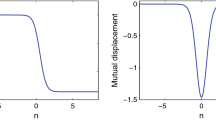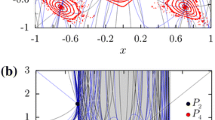Abstract
We present the results of the analytical as well as numerical study of the stationary and nonstationary dynamics of the sine-lattice. The latter is the discrete constitutive model used in various fields of physics, in particular, for the description of flexible polymers, quasi-one-dimensional spin chains, biopolymers, etc. To analyze the sine-lattice dynamics, we introduce the complex functions that allow us to determine the nonlinear normal modes as the stationary solutions to the equations in the wide range of the oscillation amplitudes and the wavenumbers. We present the dispersion relations in the analytical form. Analysis of the slow nonstationary processes allows us to determine the conditions of energy localization in the chain. We observe a good agreement between the analytical and numerical values of the localization thresholds for the chains of different lengths. In the long-wavelength approximation, the sine-lattice is equivalent to the Frenkel–Kontorova model. We demonstrate in the continuum limit that the equation is reduced to the nonlinear Schrödinger equation instead of the well-known sine-Gordon equation. We reveal the conditions of the existence of a breather-like solution and reduce the analytical representation for the small-amplitude approximation. We consider nonstationary dynamics of the forced oscillations for the undamped system in terms of the limiting phase trajectory; its bifurcations determine the change of the oscillatory regimes. We discuss the effect of damping on the slow system dynamics. We also present the generalized equation for the stationary amplitude of the forced oscillations in the presence of the damping.













Similar content being viewed by others
Data availability
The datasets generated during and/or analyzed during the current study are available from the corresponding author on reasonable request.
Notes
It is in the contrast with the dependence, which has been obtained in the previous paper [22]. This discrepancy is caused by the difference in the normalizing occupation number X. Therefore, the dependences obtained in [22] should be associated with the amplitude of complex function \(\psi _j\) rather than the amplitude of the pendulums’ oscillations.
References
Bogoliubov, N., Mitropolsky, Y.A.: Asymptotic Methods in the Theory of Non-linear Oscillations. Gordon and Breach, New York (1961)
Braun, O.M., Kivshar, Y.S.: Nonlinear dynamics of the Frenkel–Kontorova model. Phys. Rep. 306, 1–108 (1998)
Braun, O.M., Kivshar, Y.S.: The Frenkel–Kontorova Model: Concepts, Methods, and Applications. Springer, Berlin (2004)
Dodd, R.K., Eilbeck, J.C., Gibbon, J.D., Morris, H.: Solitons and Nonlinear Wave Equations. Academic Press, New York (1992)
Esmailzadeh, E., Younesian, D., Askar, H.: Analytical Methods in Nonlinear Oscillations. Approaches and Applications. Springer, Dordrecht (2019). https://doi.org/10.1007/978-94-024-1542-1
Flach, S., Wllis, C.: Discrete breathers. Phys. Rep. 295(5), 181–264 (1998)
Kovaleva, M., Smirnov, V., Manevitch, L.: Nonstationary dynamics of the sine lattice consisting of three pendula (trimer). Phys. Rev. E 99, 012209 (2019). https://doi.org/10.1103/PhysRevE.99.012209
Krylov, N., Bogoluibov, N.: Introduction to Non-linear Mechanics. Princeton University Press, Princeton (1943)
Leon, J., Manna, M.: Multiscale analysis of discrete nonlinear evolution equations. J. Phys. A Math. Gen. 32(15), 2845–2869 (1999). https://doi.org/10.1088/0305-4470/32/15/012
Malomed, B.A.: The Sine-Gordon Model: General Background, Physical Motivations, Inverse Scattering, and Solitons, pp. 1–30. Springer, Berlin (2014). https://doi.org/10.1007/978-3-319-06722-3
Manevitch, L.: New approach to beating phenomenon in coupled nonlinear oscillatory chains. Arch. Appl. Mech. 77, 3011 (2007)
Manevitch, L.I., Romeo, F.: Non-stationary resonance dynamics of weakly coupled pendula. EPL (Europhys. Lett.) 112(3), 30005 (2015)
Manevitch, L.I., Smirnov, V.V.: Limiting phase trajectories and the origin of energy localization in nonlinear oscillatory chains. Phys. Rev. E 82, 036602 (2010)
Manevitch, L.I., Smirnov, V.V.: Resonant Energy Exchange in Nonlinear Oscillatory Chains and Limiting Phase Trajectories: From Small to Large System. CISM Courses and Lectures, vol. 518, pp. 207–258. Springer, New York (2010)
Manevitch, L.I., Smirnov, V.V.: Semi-inverse method in the nonlinear dynamics. In: Mikhlin, Y. (ed.) Proceedings of the 5th International Conference on Nonlinear Dynamics, September 27–30, 2016, Kharkov, Ukraine, pp. 28–37 (2016)
Mazo, J.J., Ustinov, A.V.: The Sine-Gordon Equation in Josephson-Junction Arrays, pp. 155–175. Springer, Berlin (2014). https://doi.org/10.1007/978-3-319-06722-3
Mickens, R.E.: Truly Nonlinear Oscillators: An Introduction to Harmonic Balance, Parameter Expansion, Iteration, and Averaging Methods. World Scientific Publishing Co., Pte. Ltd, Singapore (2010)
Peyrard, M., Dauxois, T.: Physics of Solitons. Cambridge University Press, Cambridge (2006)
Sanders, J.A., Verhulst, F., Murdock, J.: Averaging Methods in Nonlinear Dynamical Systems, 2nd edn. Springer, New York (2007)
Scott, A.C.: A nonlinear Klein–Gordon equation. Am. J. Phys. 37, 52–61 (1969)
Scott, A.C.: Nonlinear Science: Emergence and Dynamics of Coherent Structures, 2nd edn. Oxford University Press, Oxford (2003)
Smirnov, V.V., Kovaleva, M.A., Manevitch, L.I.: Nonlinear dynamics of torsion lattice. Rus. J. Nonlin. Dyn. (2018). https://doi.org/10.20537/nd180203
Smirnov, V.V., Manevitch, L.I.: Limiting phase trajectories and dynamic transitions in nonlinear periodic systems. Acoust. Phys. 57, 271 (2011)
Smirnov, V.V., Manevitch, L.I.: Large-amplitude nonlinear normal modes of the discrete sine lattices. Phys. Rev. E 95, 022212 (2017)
Smirnov, V.V., Shepelev, D.S., Manevitch, L.I.: Localization of low-frequency oscillations in single-walled carbon nanotubes. Phys. Rev. Lett. 113, 135502 (2014). https://doi.org/10.1103/PhysRevLett.113.135502
Takeno, S., Homma, S.: Topological solitons and modulated structure of bases in DNA double helices: a dynamic plane base-rotator model. Prog. Theor. Phys. 70(1), 308–311 (1983)
Takeno, S., Homma, S.: A sine-lattice (sine-form discrete sine-Gordon) equation-one-and two-kink solutions and physical model. J. Phys. Soc. Jpn. 55(1), 65–75 (1986)
Takeno, S., Peyrard, M.: Nonlinear modes in coupled rotator models. Phys. D Nonlinear Phenom. 92(3), 140–163 (1996). https://doi.org/10.1016/0167-2789(95)00284-7
Takeno, S., Peyrard, M.: Nonlinear rotating modes: Greens-function solution. Phys. Rev. E 55, 1922 (1997)
Yakushevich, L.: Nonlinear Physics of DNA. Wiley, Weinheim (2004)
Zhang, Z., Koroleva, I., Manevitch, L.I., Bergman, L.A., Vakakis, A.F.: Nonreciprocal acoustics and dynamics in the in-plane oscillations of a geometrically nonlinear lattice. Phys. Rev. E 94, 032214 (2016)
Acknowledgements
The authors are grateful to the Russian Science Foundation (Grant 16-13-10302) for the financial supporting of this work.
Author information
Authors and Affiliations
Corresponding author
Ethics declarations
Conflict of interest
The authors declare that they have no conflict of interest.
Additional information
Publisher's Note
Springer Nature remains neutral with regard to jurisdictional claims in published maps and institutional affiliations.
Appendices
Appendix A: Multi-scale expansion
Substituting expression (7) into Eq. (6) and multiplying the latter by factor \(e^{i \omega \tau _0} \), we should keep the terms of lower orders of a small parameter. In such a case, we obtain:
Separating the terms with different orders of \(\varepsilon \), we can write in zeroth order:
Thus, function \(\psi _{j,0}\) does not depend on the fast time \(\tau _0\).
\( \varepsilon ^1:\)
After integrating over fast time \(\tau _0\), the fast oscillating terms vanish. The terms that contain the main order function \(\psi _{j,0}\) do not depend on the fast time, and integrating leads to the secular term. Performing the summation, we get Eq. (8). So, we conclude that
Appendix B: Integral of the occupation numbers
Using Eq. (13), we can receive evidence that the occupation number X is the integral of motion in the slow timescale:
It is easy to show that transformation (16) preserves the occupation number in the form (18):
Rights and permissions
About this article
Cite this article
Smirnov, V.V., Kovaleva, M.A. & Manevitch, L.I. Stationary and nonstationary nonlinear dynamics of the finite sine-lattice. Nonlinear Dyn 107, 1819–1837 (2022). https://doi.org/10.1007/s11071-021-07085-9
Received:
Accepted:
Published:
Issue Date:
DOI: https://doi.org/10.1007/s11071-021-07085-9




